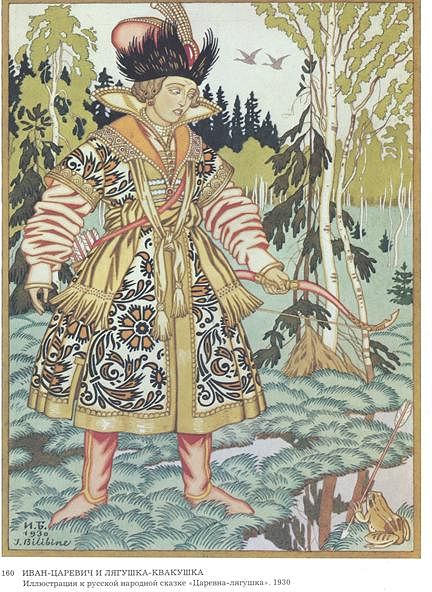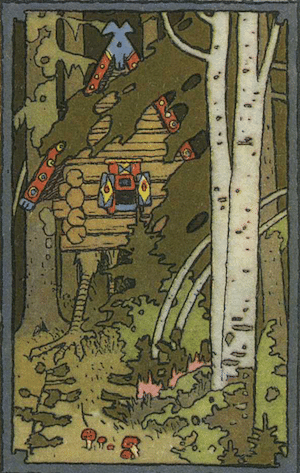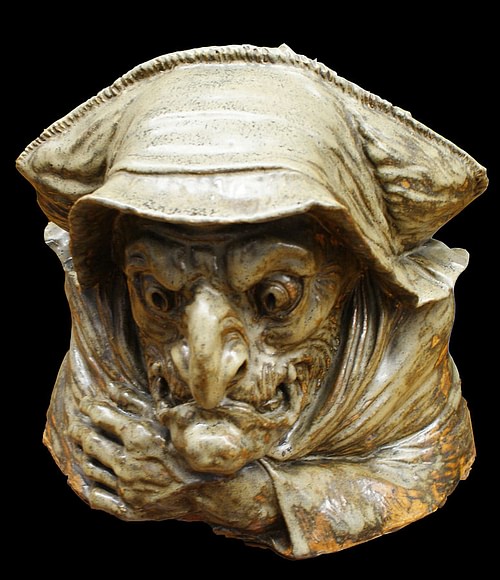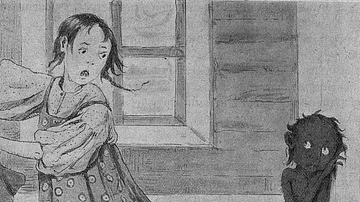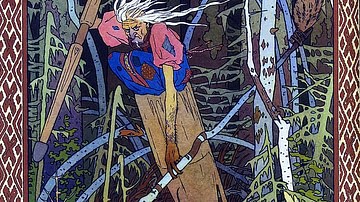The Frog Princess is a Slavic folktale focusing on the importance of recognizing someone’s inner beauty, regardless of their outward appearance, as well as the possibility of redemption after failure. The tale has many variants and appears in Czech, Hungarian, Italian, and Russian folk works as well as many others.
In the most popular version of the tale, from Russia, a prince who has married a frog discovers she is a beautiful and magical maiden but betrays her trust, forcing her to leave him. He must then embark on a quest to prove himself and win her back. The frog princess in this version is known as the fairy Vasilissa the Wise, but the heroine is not the same character as Vasilissa the Beautiful from the folktale of the same name featuring the witch Baba Yaga.
The Russian version is well-known for the dramatic twist it puts on the character of Baba Yaga who is seen here as a helpful entity, rather than as an evil, child-devouring hag, whose mystical powers are symbolized by the number three as there are three baba yagas, each of whom progress the plot. The tale is representative of the animal bride and offended supernatural wife motif, which appears in several legends from different cultures. The Slavic tale has nothing to do with the modern-day novel The Frog Princess by E. D. Baker which formed the basis for the 2009 Disney animated film of the same name.
Origin & Motif
The form of the story derives from one of the most ancient, the animal tale, made famous through Aesop’s Fables but first appearing in Mesopotamia. An animal tale uses animals as characters either to explain something (e.g. how the dog got its tail) or to impress some moral on an audience (as in the well-known Aesop tale, The Fox and the Grapes). Scholars Maria Leach and Jerome Fried comment:
The line between the literary and folk fable is not easy to determine, since tales from collections like that attributed to Aesop have had wide popular circulation and have been taken from and gone back into oral traditions of large groups of people. However, the area of contact between the didactic, moralizing fable and folklore is slight, for the animal tale proper is meant essentially to entertain. The hearer is required to suspend belief and see the animal speaking, thinking, and acting like a human being. (61-62)
In the tale of The Fox and the Grapes, for example, the fox behaves like a petulant child when he cannot reach the overhanging grapes and finally walks away saying they were probably sour anyway (inspiring the phrase "sour grapes" referring to someone who rationalizes a failure to get what they want). For the tale to be effective, an audience must accept the world of the tale in which foxes can speak, reason, and rationalize. In this same way, The Frog Princess relies on the suspension of disbelief at a talking frog who is able to perform transformational magic.
The tale is similar in many ways to the better-known The Frog Prince (also known as The Frog King) in which the youngest of three princesses drops her gold ball into a well by accident and it is retrieved by a frog after she promises she will be his companion. Once the frog returns her ball to her, however, she breaks her word and runs away. The frog then follows to force her to keep her promise. The princess only accepts the frog once she finds out he is actually a handsome prince and, according to different versions, she is either rewarded for her kindness or punished for being shallow and selfish.
The Frog Princess also has the main character show kindness to the creature but later betray its trust and also uses the device of the youngest of three as this was a popular motif in folktales. The youngest son would usually receive no inheritance, and the youngest daughter was married last and so might have the poorest dowry. Folktales balanced this perceived injustice by frequently featuring the youngest of the family as the hero or heroine.
The Tale
The story begins with a king and queen who have three noble sons, all of whom possess the finest characteristics, but the youngest, Prince Ivan, is the best of them. When the boys reach the age of marriage, instead of marrying them off in order, the king tells them to take their bows and fire an arrow into the fields around his castle, each in a different direction; whoever returns their arrows to them will become their wives.
The sons do as they are instructed, and the eldest brother finds his arrow returned by the daughter of a nobleman, the second by one of a wealthy merchant, but Ivan cannot find his arrow anywhere. He searches for three days until he comes upon a frog sitting in the middle of a dark swamp holding the arrow in its mouth. Ivan is infuriated and starts back toward his father’s castle empty-handed, but the frog calls out, telling him he must honor his father’s wishes, retrieve the arrow, and take her as his wife, or he will never find his way back home.
Ivan returns to the castle with the frog only to be mocked by his older brothers and their beautiful fiancés. He tells them the story but refuses to marry the frog who is obviously beneath his status as a prince. The king reminds him that his word is law and decrees that he must marry the frog. Ivan is hardly pleased with this outcome but treats the frog kindly, marries her, and brings her back to their new home where they live together happily.
In time, the king summons his sons and tells them he wants to see how their wives perform household tasks. He tells each to take a piece of linen from his storehouse and have their wives make him a shirt by the next morning. Ivan returns home with his linen despondent and tells the frog she is expected to make his father a fine shirt by morning, which, he says, is impossible and they will be shamed. The frog tells him not to worry, and after he has gone to bed, she performs a magic spell, and the shirt is created. The next morning, Ivan brings the shirt to his father along with his brothers. His father examines the eldest brother’s shirt and declares it fit only for a peasant. He looks over the second brother’s shirt and dismisses it as only good enough to wear to the bath. He is astounded by Ivan’s shirt, however, and commends Ivan’s wife for having made a garment so beautiful it will be worn only on special occasions.
After the shirt, the king demands the wives bake him a loaf of bread, and the same thing happens, with Ivan’s wife’s bread declared the best. The two other women spy on the frog to see how she is creating such magnificent things, but they cannot replicate them. The king then asks them to make him a carpet woven of gold and silver, and again, Ivan’s wife creates the best while the other two are insulted for their efforts. After this, the king commands the wives be presented to him the next day so he can thank them in person for their work.
Ivan is again upset because he will have to appear with a frog while his brothers have beautiful wives, but when he tells the frog she must make an appearance, she again tells him not to worry. The next morning, she tells him to go to the castle and listen for her carriage, and when she arrives, she is a stunningly beautiful princess who outshines all the others there. The king commends her, and a great feast is held, but during the festivities, Ivan fears his wife turning back into a frog and sneaks out, goes home, finds her frog skin, and burns it.
When his wife finds out, she cries that he has betrayed her and that she must leave now. She will be forever lost to him, she says, unless he can find her in the land that lies under the sun in the 30th kingdom beyond the nine lands. She tells him her name, Vasilissa the Wise, then turns into a dove, flies away, and Ivan is left crying alone.
Ivan begins his quest and finds an old man who tells him that Vasilissa is a fairy whose father cursed her by turning her into a frog for three years. If Ivan had only been patient, the three years were almost up, and she would have returned to her natural form. He feels sorry for Ivan, though, and gives him a magical ball that will help guide him toward his wife.
The ball leads him into a dark forest where he comes upon the hut of Baba Yaga standing on its chicken legs and turning round and round. After Ivan makes the hut stand still and enters, Baba Yaga asks him if he came of his own free will or was forced, and Ivan answers that it was partly his will and partly forced, but that is not as important as hospitality since she has failed to offer him food or drink or a hot bath.
Baba Yaga is impressed by the prince’s answer as it shows spirit and courage and provides him with all three. Afterwards, he tells her his story, and she agrees to help him because she hates Vasilissa’s father and knows interfering with his plans will enrage him. She tells Ivan that Vasilissa flies through the forest every day delivering and receiving messages for her father and stops at the hut. She tells Ivan:
Stay here and wait for her. As soon as she comes in, grab her by the head. When she feels herself caught, she will transform into a frog, then a lizard, then a snake, and last of all an arrow. Break the arrow into three pieces and she will be yours forever. But beware! Once you take hold of her, do not let her go!” (Wiginton, 54)
The fairy comes into the hut, and Ivan catches her. When she turns into a frog, he smiles to see her again as he knew her, but when she becomes a lizard, he is disgusted and drops her, and the lizard runs away. Baba Yaga is disappointed in him but says he has another chance at her sister’s hut. At the sister’s hut, he again catches the fairy and holds her when she becomes the lizard but drops her when she turns into a snake. Baba Yaga’s sister is also disappointed in Ivan, telling him he does not deserve such a wife if he cannot even handle a snake but sends him on to her younger sister.
At the younger sister’s house, he is warned that if he fails this time, he will never see Vasilissa again in this life. Ivan prays for strength, and when the fairy flies in through the window, he grabs her. She makes her usual transformations, but he holds on tight until she becomes an arrow, which he quickly breaks into three. Vasilissa assumes her natural form, embraces and forgives him, and the Baba Yaga is so happy for the couple that she gives them a white mare that flies them back over the nine lands to Ivan’s father’s realm. They are welcomed back, Ivan is made his father’s heir, and everyone lives happily ever after.
Symbolism & Message
The story follows the paradigm of most, if not all, folktales by inverting traditional customs and rites while delivering an important cultural message. The three princes are married at once instead of the older brothers receiving preferential treatment, and the presumably older wives are outdone by the youngest. It also takes a traditional villainous character, Baba Yaga, and transforms her into a helpful spirit who is instrumental in helping the hero achieve the goal of his quest. The Frog Princess, as noted, is similar to many other animal bride tales but highlights the weakness of the hero, almost to the very end, through his inability to see past appearances and appreciate the inner beauty of his wife, no matter what form she takes. Scholar Andreas Johns comments:
The hero proves his love for his wife when he must hold on to her even as she turns into a frog, lizard, and snake. The tale ends happily when outward circumstances (the princess’ appearance in human form) reflect inner qualities. The tale causes the listener to ponder true human values. (152)
This is true not only of the hero’s initial revulsion toward the frog and later disgust at the lizard and snake but also an audience’s reaction to Baba Yaga. Baba Yaga routinely appears in Slavic lore as a menacing witch riding in a mortar propelled by a pestle with a broom sweeping away any trace of her path behind her, who searches for young children she can eat. She rarely appears as anything other than an evil witch, and even when she is helpful, as in the tale Maria Morevna, it is against her will. In this story, however, she recognizes the hero’s worth even though he does not seem to, and her sisters do the same, up to the point of giving the couple a magic horse to bring them back home. Johns notes:
Specific fantastic motifs are reflections of social customs of the past (the tale’s preference for the third son, who in ancient times inherited nothing) and totemism (the hero’s marriage to a frog). The tale hints at a relationship between Baba Yaga and the frog [in that the fairy stops at her house every day to rest]. Because she is now related to the hero [through her relationship with the frog], it is natural for Baba Yaga, a protective spirit, to help him. The later folklore tradition [in which Baba Yaga is evil] has given these mythological conceptions a new meaning. (152)
Baba Yaga is recognized as a trickster figure – a mythological character who often does bad things which then lead to transformation – and this entire tale embodies the trickster figure. Tricksters might appear evil but can bring about important change leading to something good. Nothing and no one in the story behave as they are expected to – the frog is actually a fairy, the evil witch is a helpful spirit, the brave prince cannot handle a lizard or snake – and this would suggest to an audience caution in jumping to conclusions about people and events in their own lives.
Conclusion
Along with the moral of not judging others by their appearance is the hope of second chances and forgiveness. Each time Ivan’s father demands his wife make some new object, Ivan is despondent when he tells his wife about it, hopeless in the face of what he considers impossible tasks. Even after his wife shows him he should trust her, he still doubts, and his fears finally culminate in his act of betrayal when he burns her frog skin.
After these initial failings, Ivan continues to stumble at the hut of Baba Yaga but is given a second, and then a third chance at her sisters’ homes. Baba Yaga and her sisters do not abandon Ivan to his weakness but forgive him and encourage him to try again. Ivan, for his part, does not give up on Vasilissa even after she has escaped from him as a lizard and then a snake, and it is for the same reason Baba Yaga and her sisters help him: because he is finally able to see beyond superficial appearances to what is really important in life. In the end, he holds onto these values to complete his quest, become whole again with his wife, and, as the story goes, live happily ever after.
